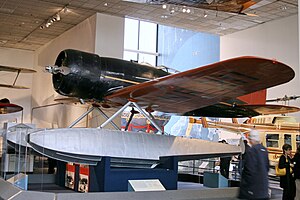avia.wikisort.org - Aeroplane
The Lockheed Model 8 Sirius was a single-engined, propeller-driven monoplane designed and built by Jack Northrop and Gerard Vultee while they were engineers at Lockheed in 1929, at the request of Charles Lindbergh. Two versions of the same basic design were built for the United States Air Force, one made largely of wood with a fixed landing gear, and one with a metal skin and retractable landing gear, designated Y1C-25 and Y1C-23, respectively. Its basic role was intended to be as a utility transport.[1]
| Model 8 Sirius | |
|---|---|
 | |
| Sirius at National Air and Space Museum | |
| Role | Utility transport |
| Manufacturer | Lockheed Aircraft Limited |
| Designer | Jack Northrop Gerard Vultee |
| First flight | 1929 |
| Introduction | 1929 |
| Number built | 15 |
History
A total of 15 Sirius aircraft were constructed in 1929 and 1930.[2]
The first and best known Sirius was bought by Lindbergh, and in 1931, as NR-211, it was retrofitted to be a float plane.[3] Lindbergh and his wife Anne Morrow Lindbergh flew it to the Far East, where she wrote a book about their experiences there entitled North to the Orient.[3] The aircraft was damaged in Hankou, China, when it accidentally capsized while being lowered off the aircraft carrier HMS Hermes, and had to be sent back to Lockheed to be repaired.[4]
In 1931, György Endresz and Sándor Magyar made a successful US–Hungary transatlantic flight with a Lockheed Sirius 8A aircraft named "Justice for Hungary".[5]
In 1933, the Lindberghs set out again with their Sirius, now upgraded with a more powerful engine, a new directional gyro, and an artificial horizon. This time, their route would take them across the northern Atlantic, with no particular destination, but primarily to scout for potential new airline routes for Pan Am.[6] While at a refueling stop in Angmagssalik, Greenland, the Inuit of the area gave the Sirius a nickname, "Tingmissartoq" or "one who flies like a bird". They continued on their flight and made many stops in Europe, Russia, then south to Africa, back across the southern Atlantic to Brazil and back over the skies of New York City at the end of 1933, after 30,000 miles and 21 countries; droves of people turned out to greet them as they landed.[3]
The aircraft was in the American Museum of Natural History in New York City until 1955, when ownership was transferred to the National Museum of the United States Air Force in Dayton, Ohio. It was given to the Smithsonian Institution in 1959, and it went on display at the National Air and Space Museum when the original facility opened on the National Mall in 1976.[3]
Variants

- Lockheed 8 Sirius
- Single-engine, two-seat, long-range, high-performance aircraft; one built for Charles Lindbergh.[7]
- Sirius 8
- First production version, similar to the Lockheed 8 Sirius; one built.
- Sirius 8A
- Equipped with an enlarged tail surface; eight built.[8]
- Sirius 8C
- Four-seat version fitted with an enclosed cabin seating two passengers, located between the engine and the pilot's cockpit; one built.
- DL-2
- Metal fuselage and wooden wings. One built by the Detroit Aircraft Corporation.
Operators
 Spain
Spain
- Spanish Republican Air Force[9]
Specifications (Lindbergh's Sirius 8)

Data from Lockheed Aircraft since 1913[10]
General characteristics
- Crew: two
- Length: 27 ft 1 in (8.26 m)
- Wingspan: 42 ft 9+1⁄4 in (13.037 m)
- Height: 9 ft 3 in (2.82 m)
- Wing area: 294.1 sq ft (27.32 m2)
- Empty weight: 4,289 lb (1,945 kg)
- Gross weight: 7,099 lb (3,220 kg)
- Fuel capacity: 416 US gal (1,570 l; 346 imp gal)[11]
- Powerplant: 1 × Pratt & Whitney Wasp radial engine, 450 hp (340 kW)
Performance
- Maximum speed: 185 mph (298 km/h, 161 kn)
- Cruise speed: 150 mph (240 km/h, 130 kn)
- Range: 975 mi (1,569 km, 847 nmi)
- Service ceiling: 26,100 ft (8,000 m)
- Rate of climb: 1,280 ft/min (6.5 m/s)
See also
- List of Lockheed aircraft
References
Notes
- "Airplanes and Rockets": Lockheed Sirius History, April 1973." American Aircraft Modeler. Retrieved: November 26, 2015.
- Donovan, M. Regis. "A Short History of the Wooden Wonders." Archived 2015-12-08 at the Wayback Machine rustysparks.com. Retrieved: November 26, 2015.
- "Lockheed Sirius "Tingmissartoq", Charles A. Lindbergh." Smithsonian National Air and Space Museum. Retrieved: November 26, 2015.
- "Lucky Lindy and His Lockheed Sirius." Archived 2015-12-07 at the Wayback Machine Lockheed Martin. Retrieved: November 26, 2015.
- Dawson, Brian. ""Justice for Hungary" - a historic flight, 1931." American Hungarian Federation. Retrieved: November 26, 2015.
- "Lockheed's Early Years, 1912-1940." centennialofflight.net, 2013. Retrieved: November 26, 2015.
- "Lindbergh Picks A Plane." Popular Mechanics, November 1930. Retrieved: November 26, 2015.
- "Lockheed Sirius 8A NC117W." Delta Mike Airfield, 2008. Retrieved: November 26, 2015.
- Nash, David. "Aircraft that took part in the Spanish Civil War." Aircraft of the Spanish Civil War. Retrieved: January 15, 2015.
- Francillon 1982, p. 100.
- Francillon 1982, p. 93.
Bibliography
- Francillon, René J. Lockheed Aircraft since 1913. London: Putnam, 1982. ISBN 0-370-30329-6;
External links
На других языках
- [en] Lockheed Model 8 Sirius
[fr] Lockheed Model 8 Sirius
Le Lockheed Model 8 Sirius est un avion monoplan monomoteur, conçu et construit par Jack Northrop et Gerard Vultee alors qu'ils étaient ingénieurs chez Lockheed en 1929, à la demande de Charles Lindbergh. Deux versions différentes furent construites pour l'United States Air Force, l'une faite en grande partie de bois avec un train d'atterrissage fixe et l'autre avec un revêtement métallique et un train d'atterrissage rétractable, désigné respectivement Y1C-25 et Y1C-23. Il servit principalement pour le transport.Другой контент может иметь иную лицензию. Перед использованием материалов сайта WikiSort.org внимательно изучите правила лицензирования конкретных элементов наполнения сайта.
WikiSort.org - проект по пересортировке и дополнению контента Википедии